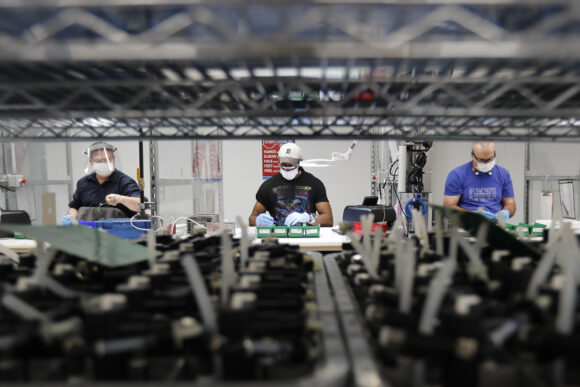WASHINGTON (AP) _ Industrial output fell sharply in February as severe winter storms battered much of the country, disrupting a wide range of manufacturing activities from autos to chemical plants.
The expectation is that the drop will be temporary although there are concerns about growing global supply chain problems.
The Federal Reserve reported Tuesday that industrial production fell 2.2% in February, reflecting a big decline in output at factories and oil and gas refineries.
Industrial production fell 2.2% last month interrupting a string of four positive monthly gains as U.S. factories recovered from the pandemic-induced recession of last spring. Industrial production had been up 1.1% in January and 1% in December.
The drop in February reflected a 3.1% fall in manufacturing and a 5.4% decline in mining, a category that includes oil and gas production. The only sector showing an increase last month was utilities, where output rose by 7.4% as power production increased to meet heating needs during the severe winter weather that hit much of the country in mid-February.
The weather damage disrupted the Texas power grid, resulting in millions of people going without electricity for an extended period of time. The deep freeze along the Gulf Coast caused serious damage at oil refineries and chemical plants, putting them offline for an extended period.
Without the adverse winter impact, manufacturing would have fallen by a smaller 0.5% rather than the 3.1% drop while the mining sector would have actually risen by around 0.5%, the Fed said.
Output at auto plants dropped 8.3% in February with a part of that decline blamed on global shortages of semiconductors. Output at chemical plants feel by 7.1%, another weather-related decline.
While analysts believe the weather disruptions will quickly be reversed, there is more concern about global supply chain problem.
“The big concern is that the supply problems in the auto industry are the tip of the iceberg of more widespread global supply constraints,” Michael Pearce, senior U.S. economist at Capital Economics, said in a research note.
However, other analysts forecast continued solid gains in manufacturing output in coming months as the acceleration of vaccinations along with the new $1.9 trillion stimulus package help to support faster economic growth.
“Recovery in output, especially manufacturing, is ongoing and is likely to remain well-supported by government payments … boosting demand for goods,” said Rubeela Farooqi, chief U.S. economist at High Frequency Economics.
The Fed said that total industrial production in February was 4.2% below the level of February 2002, the month before the pandemic hit with force in the United States.
U.S. industry operated at 73.8% of capacity in February, down from 75.5% of capacity in January.
About the photo: In this May 13, 2020, file photo, Ford Motor Co., line workers put together ventilators that the automaker is assembling at the Ford Rawsonville plant in Ypsilanti Township, Mich. Severe winter weather pushed industrial production down a sharp 2.2% in February, reflecting a big decline in factory output. The Federal Reserve reported Tuesday, March 16, 2021, that the sharp fall in industrial output interrupted a string of positive gains beginning in October as U.S. factories were recovering from the pandemic-induced recession of last spring.
Was this article valuable?
Here are more articles you may enjoy.


 NYC Tourist Helicopter Crashes in Hudson River, Killing Six
NYC Tourist Helicopter Crashes in Hudson River, Killing Six  Jack Dorsey’s Block to Pay New York $40 Million in Cash App Settlement
Jack Dorsey’s Block to Pay New York $40 Million in Cash App Settlement  In Fight Over Insurance, Neighbors Crowdsource LA Fire Contamination Data
In Fight Over Insurance, Neighbors Crowdsource LA Fire Contamination Data  Hedge Funds Are Hunting Deals in Risks Too Big for Insurers
Hedge Funds Are Hunting Deals in Risks Too Big for Insurers 